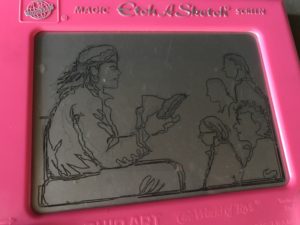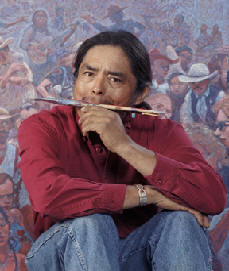 Recently, I did a school visit with Ms. Julia’s second grade class in Cornville. As with most school visits, it was a treat and inspiring to see them. I drove through Oak Creek Canyon, through Sedona, and down into the expansive Verde Valley. Along the way, I pulled off the road a couple times to sit atop my camper shell and draw the beauty of the space. In this manner, I prepared myself for the class of eager young artists.
Recently, I did a school visit with Ms. Julia’s second grade class in Cornville. As with most school visits, it was a treat and inspiring to see them. I drove through Oak Creek Canyon, through Sedona, and down into the expansive Verde Valley. Along the way, I pulled off the road a couple times to sit atop my camper shell and draw the beauty of the space. In this manner, I prepared myself for the class of eager young artists.
Vehicles blew by as I sat deep in meditation, coaxing out the red rocks onto the sketchbook. I had brought my pad of black pages so I could use light to bring forms into being rather than the shadows as one would on a white page. As I drew, the shadows on the distant rocks shifted so I had to keep my hands and eyes moving as well. As I sat, I thought about how blessed and gifted we are with the ability to appreciate beauty in the most profound of manners, as poets and musicians well know. I believe every child is gifted with this innate potential to be lifelong practitioners of art. Unfortunately, sometimes it’s schooled out of us. We are given rules and limited space to roam in beauty. I wondered how many of the cars blowing by actually see the sacred languages of landscape all around us. As I sat there caressing the surface of the paper, I roamed inside my head back to all the times and places I traveled to visit with classrooms full of budding artists.
As a young child in Shonto Community School way back when, I don’t remember being encouraged nor taught art. It was something I discovered and hung onto myself for distractions from the harshness of the Bureau of Indian Affairs education system. To create and compose my world away from our collective reality. This is what I mean by Art Saves Lives. It did mine.
The first time I ever saw an artist painting from a landscape was at Shonto Canyon. As a class, we were treated to an artist painting below the giant cottonwood. He was bringing out the dappling light of the green sheen and the brilliant red of the canyon wall in an impressionistic way. Some students took a cursory look and just saw slabs of pigment on canvas. I saw something deeper in the composition. I caught something that day beneath the canyon walls and shimmering light through boughs of cottonwood.
I value the practice of visiting and working with young students through art as an established artist. We can never underestimate the importance of those connections. In these days when we stare more into our cell phones than we do each other, creative outlets and means are overlooked. Even what passes as art is generated outside of us, and that is not good. Young minds are likened to a sponge taking it all in. The stirring of imagination and to encourage it should always be our jobs whenever and wherever we can. To give the next generation the tools to make our world more beautiful in the love of all art forms. In doing school visits, I always look forward to coming away a bit more wise. I find that is a two-way exchange. They learn from me as I pick up on their wisdom in innocence. Their gestures and words remain with me.
There was a time in the early 1990s when I practically lived out of my suitcase. I was flying all over the country to answer school visit requests every few weeks, lugging around my bulky portfolios. The requests were fulfilled, and since flying was involved, and time out of studio, I made sure it was for more than just classroom visits. Often several schools went in together to get me out to them. Evening sessions with parents and teachers as well as time in various independent bookstores with book signings—I had several children’s books out in circulations at the time. Since my visits were announced in local papers, in various cities, Diné people on the way fringes attended and met other Diné they never knew were near, so it was also an event that brought us all together.
The sun had moved farther up across the heavens, so I climbed off my camper shell and continued my journey to enlightenment. Driving through the draw on Beaverhead Flat, I thought about this school in Cornville I have yet to visit. I had arranged this through my friend Julia and I was eager to see her second grade students—a good age for exploration deeper into the art of that visual communication. Second grade for me was brutal; I delved into art to remain gentle at heart.
I drove into Cornville on a very beautiful and sunny Friday. The cloudless sky and the way all solid objects drew in their shadows held promises for me as well. I drove onto the gravely parking lot of Desert Star Community School.
Twenty-one smiling faces greeted me as I introduced myself in my own language. It’s important for them to know the beauty of other languages that share the region with them before we went into the universal language of art. I enjoy sharing the art prints I use to illustrate my talks. Giving narratives and spirit to each image shared is a way to show them that art must have languages, heart and stories. The books I carry around to school visits I also use to connect us as universally the same, share the same need to laugh in awe. I read them my second release, Ma’ii’ and Cousin Horned Toad, as I animated the dialogues of both Coyote and Horned Toad. I shared their songs and chants. It was a blessing ceremony as well. Engaging them in the actual making of art depends on time constraints, and most times I just set them up to practice on their own. I share with them the healing power and the value of creating beauty. I usually have them test their own power of imagination through cryptic scribbles I place on the chalkboard. A quick wild motion handout and they visualize an image. I invite them to come up to finish the scribble by coaxing out that language through their imagination. This part is always fun. Just as I chose that day to draw by bringing out the light onto the black surface, I have them bring out their own visual order out of chaos. There’s not a bored face to be found anywhere near this ceremony.
I enjoy drawing for them their requests of images: dragons, animals and objects. Etch A Sketch comes in handy here and I hope some fly off the department store shelves.
I bid them farewell as they clung to me pleading for me to visit third grade next year—I will visit them again this spring. I come home gifted with a stack of their drawings. I come home a little more childlike in spirit. I come home wiser for having spent time with innocence and eager minds. I feel adopted by Julia’s second grade class. Desert Star has a place in my heart now. In these days of school budget cuts, especially, I hope we all do our part for the arts and for the kids. Blessed is the next generation.

